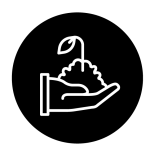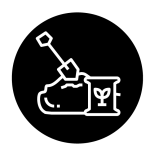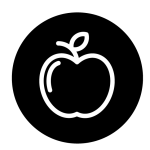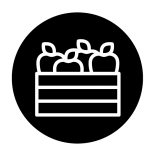Under the name The Apples from Grojec can be offered only premium Apples (Extra and I) with specyfice requirements for coloring, size and firmness of flesh. The farms producing grojec apples must be from this region and are obliged to participate in food safety standard Integrated Production or GLOBALG.A.P.
The production group are also obliged to regular quality kontrol, before sale product to retailers. In their storages common were implemented quality control standards. Numerous organizations involved in cooperation in the project and their extensive infrastructure guarantee the appropriate volume of high-quality fruit.
Selected principles of the methodology of growing The Apples from Groje

Preparation of the position
Every place to assume the orchard apples should be properly prepare.
Preparing the soil for the orchard begins with the chemical analysis of the soil, which allows to eliminate nutrient deficiencies in the soil before planting the orchard. Based on the results of soil analyzes and limit numbers of mineral content in soil, fertilizer recommendations are issued. Before planting the orchard, the soil should be prepared also by appropriate mechanical cultivation, and the cultivation of plants for green fertilizers in order to eliminate pathogenic organisms. In the absence of the use of green manure, organic fertilization in the form of manure is used.

Setting up a plantation
Trees of apples, depends of weather conditions and used type of trees are plant early autumn or spring. The applied spacing of apple tree planting is mainly dependent on the strength of the noble variety growth and the strength of the applied rootstock. The spacing is 3 to 3.5 meters row from row and 0.5 – 1.2 tree from the tree for dwarf rootstocks depending on the strength of the variety, the way of cultivating the crop and the equipment. In contrast, spacing for apple trees planted on semi-wood rootstocks is 3.5 to 4.2 meters in a row from a row and 1.2 – 2 meters sapling from a tree. For orchards planted before applying for the registration of “jabłka grójeckie”, other spans may be used.

Cutting and forming
Formation of the apple tree begins just after planting the trees by removing branches that do not fit the planned type of orchard. The formation of crowns lasts until the planned thickness is reached. Cutting apple trees is done annually at the beginning of the growing season. The main purpose of the cut is to X-ray the crown so that light access is possible to any part of the tree’s crown. At the same time, annual tree cutting is an agrotechnical procedure that affects the unique quality of fruit by providing light access to the crown, which directly affects the color of the fruit. Cutting also affects the size of fruit in a given year by removing excessive amounts of flower buds. This treatment also indirectly affects the annual harvesting of trees. In the years when there are very few flower buds, the cut is limited to the necessary minimum, so that the trees with a small amount of fruit do not grow too much.

Fertilization
Fertilization is only intervention, which has direct impact for quality produces fruits and big impact for environmental protection. From these reason fertilization is under special supervision. The amount and type of fertilizers used and the method of their application are determined. The basis for fertilization is the well-known principles of fertilizing fruit plants described, among others in the methodology of integrated production of apples. The fertilizer recommendations for a given plantation are established on the basis of regular soil analyzes, at least every 4 years, and verified on an annual basis on the basis of weather conditions, the external appearance of plants and the intensity of flowering and fruiting. In the case of symptoms of deficiencies of minerals on the leaves or fruits, foliar fertilization is applied to quickly remove deficiencies.

Irrigation
Only rationally used irrigation ensures long-term yielding and high fruit quality, as well as affects environmental protection. The basis for rational irrigation is the use of irrigation techniques that will allow you to use as little water as possible during the year, with the best fruit quality. On the farms, three types of irrigation are used: drip irrigation, sub-crown sprinklers and supercrown sprinkler irrigation. The needs for the use of irrigation are determined each time on the basis of the tensiometer reading, or in the absence of these devices, based on the observation of soil moisture. In order to reduce the evaporation of water from the soil, it is possible to apply soil mulching in rows of trees, it also affects a faster rise in soil temperature in spring and thus faster vegetation.

Plant production
Plant production before disease, pests and weeds is intervention, which has the biggest impact for quality and the size of the crop. Only a correctly diagnosed threat in the form of infection of a disease or the occurrence of a pest allows you to make the right decision about the need and method of controlling diseases, pests or weeds. Each of the growers is trained in the recognition of pests and weeds, and the selection of the correct method of control. In addition, fruit farmers regularly improve their qualifications, especially plant protection, so as to maximize the use of non-chemical methods of pest control. In the case of the need to use a chemical plant protection product, preparations are used that are least harmful to the natural environment, including natural enemies, and highly effective in combating a given pathogen.

Intervention improve quailty of fruits
In order to improve the quality of fruit during the growing season, treatments such as thinning of fruitlets and summer cutting are applied. Thinning is a procedure that aims to reduce the number of buds. Thinning is used during the flowering period to reduce the number of buds and provide annual fruiting, or during the summer season, manual thinning of distorted buds or symptoms of pests and diseases, to improve the quality of other fruits. Summer cutting, this is a procedure that involves cutting out the growths that cover fruits. The fruit exposure provided in this way helps in better coloring of the fruit.

Harvesting
Time harvesting fruits is period intensified work for growers. Due to need for long storage of fruits, they should be collected in the collective maturity phase.
Depending on the variety and the planned length of storage in specific conditions, the date of fruit harvesting is set. The basic methods for determining the date of harvest are: fruit observation, degree of coloring, color of seeds, firmness, starchy test, extract content and Index Streifa. The harvest of apples is carried out at the full maturity of the fruit if the fruit is intended for storage and consumer maturity if the fruit is intended for direct consumption. The deadline depends on the position and course of meteorological conditions in a given year. Typically, the harvest is carried out from September 10 to October 31, with the exception of early varieties. However, the exact date of the harvest is decided individually by each of the producers taking into account their knowledge and experience in this area. Harvested apples are packed into a pallet box with a capacity of approx. 300 kg and boxes with a capacity of approx. 20 kg. Harvesting of apples is done manually to preserve high quality fruit (sorting by the collector, limiting damage, etc.). It is allowed to use machines and devices facilitating the collection eg of a platform, etc. Then during transport and storage until packaging, apples are treated with the utmost care to avoid damage.

Storage
The storage of apples from Grojec should take place in the area defined in point 5, until packaging. Optimal storage conditions for apples from Grojec are: 1-3 ° C – long-term storage up to several months, 4-10 ° C – post-harvest storage, short-term storage up to a dozen or so days, The permissible storage period for apples depends on the variety. It is important that the firmness at the end of the storage period is not less than 4.5 kg / cm2. Where a producer also grows other apples not covered by a protected geographical indication, they should be stored in a way that prevents confusion. Apples intended for sale as fruit desserts should be of very good quality and should not have any defects or damage.

Packaging
Packaging the apples from Grojec should be done in area specified in point 5. In use are diffrent type of package unit and collective packaging with a capacity not exceeding 20 kg. Fruits should be package manually or by special machines minimizing mechanical damage.

